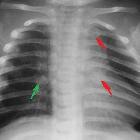metaphyseal corner fracture
Metaphyseal corner fractures, also known as classical metaphyseal lesions (CML) or bucket handle fractures, are observed in young children, less than 2 years old. It is suggestive of non-accidental injury (NAI).
Epidemiology
This injury is not only the fracture most specific for NAI, it is also common among abused children, occurring in ~50% (range 39-59%).
Pathology
The biomechanics of metaphyseal fracture is the cumulation of multiple microfractures across the metaphysis with an orientation perpendicular to the long axis of the bone. To-and-fro manipulation (shaking) is the force applied, for example holding the child around the trunk while shaking, with the limbs moving back and forth with a resultant whiplash or shear force. The microfractures occur in immature mineralized bone.
This injury occurs almost exclusively in children under 2 years of age because:
- they are small enough to be shaken
- they cannot protect their limbs
Although associated with non-accidental injury, in newborns they may be related to traumatic delivery during a breach presentation .
Radiographic features
Plain radiograph
Radiolucent area within the subphyseal metaphysis perpendicular to the long axis of the bone. The fracture extends across the metaphysis (completely or partially).
Nuclear medicine
Like other fractures, there is an increased uptake of technetium-99m methylene diphosphonate. However, intense uptake of technetium-99m methylene diphosphonate at the metaphyses is normal in young children; abnormally increased uptake may be difficult to identify. Therefore scintigraphy is considered complementary only (as far as metaphyseal corner fractures are concerned).
See also
Siehe auch:

 Assoziationen und Differentialdiagnosen zu metaphyseal fracture:
Assoziationen und Differentialdiagnosen zu metaphyseal fracture:
